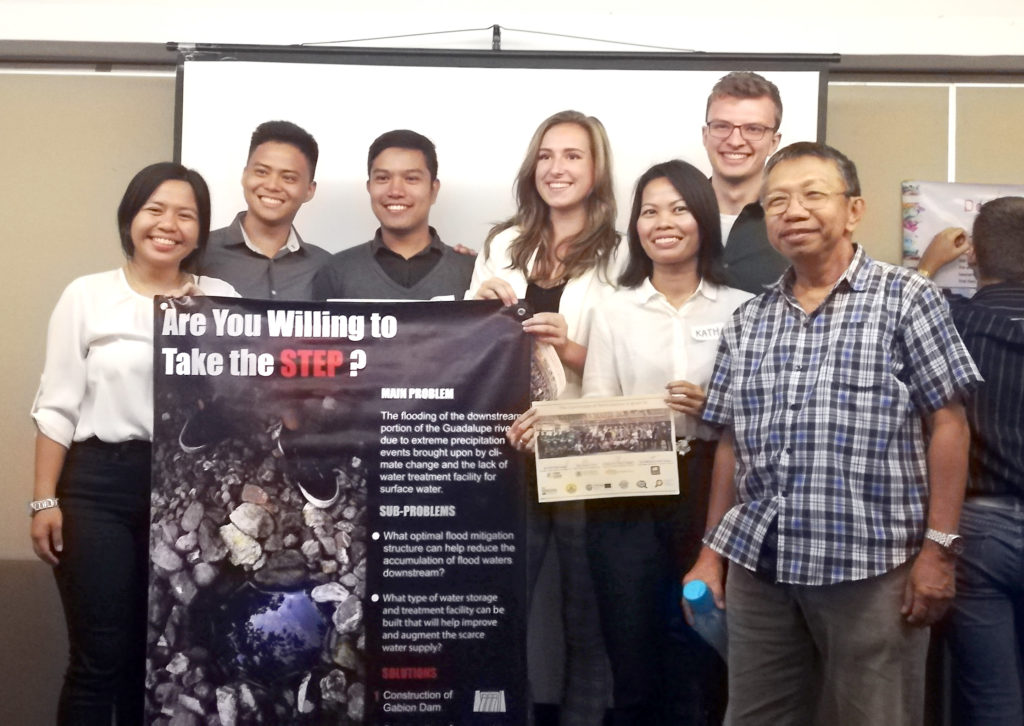
Team 1 proposes to install gabion dams upstream at Guadalupe River to capture water flowing from the springs and minimize flood accumulation downstream. The team consist of Koen van der Veer, Amber Moerland, Lance Pogoy, Kara Deguit, Engr. Dave Layos and Engr. Kathrina Borgonia. | Contributed Photo
CEBU CITY, Philippines – Six teams consisting of civil engineering students of the University of San Carlos (USC) and two Dutch universities have proposed solutions to augment water resources and rehabilitate the Guadalupe and Mahiga Rivers.
The students, with the guidance of their respective professors during their studies, presented their proposals during the culmination of the River Scan Challenge (RSC) 2019 held on October 22, 2019 at St. Mark Hotel in Cebu City.
An offshoot of the Climate Scan Challenge, the RSC is a joint program of USC and the Cebu City Government in partnership with the Rotterdam University of Applied Sciences (RUAS) and Hanze University of the Netherlands.
The Cebu Leads Foundation, Inc. has been organizing the nine-day program now on its third year in coordination with the Metro Cebu Development Coordinating Board (MCDCB), says assistant instructor Kathrina Marie Borgonia.
RSC 2019 is aimed at mapping the best management practices (BMPs) on river rehabilitation, raising awareness on ways of coping with climate change, scanning of rivers for water quality improvement, and flood management plans.
The recent round started on Oct. 12 when the city shared its current programs that involved cleaning, monitoring and rehabilitation of the 10 rivers that are located within its periphery.
TEAM 6 that consist of Mattea Otten, Inge van Beek, Ariel Casocot, Leonard Borbon, Engr. Jemimah Perodes, and Engr. Opalyn Seno proposes the distribution of smart trash bins at the downstream portion of Mahiga River. | Constributed Photo
Engr. Joel M. Reston, officer-in-charge of the Cebu City Planning and Development Office, said that Guadalupe and Mahiga Rivers, especially its downstream, are polluted, full of rubbish and plastics.
Recent massive clean-ups point to dumping of untreated sewage wastewater from piggeries, as well as industrial and domestic establishments.
DENR representative Cindylyn Pepito also said that the rivers that they monitor contain high Biological Oxygen Demand (BOD) and fecal coliform count, which can be attributed to the wastewater coming from the aforementioned sources.
Qualitative
Six teams of Filipino and Dutch students studied solutions on how ease the problems on water shortage while rehabilitating the severely polluted water from the Guadalupe and Mahiga Rivers.
The participants included three Dutch professors, ten Dutch students, eight USC faculty members and 19 USC students.
They investigated the water quality, river health, and plastic pollution of the upstream, midstream and downstream portions of the Guadalupe and Mahiga Rivers, said Borgonia.
They used test strips and sensors to measure the qualitative parameters of the river waters and questionnaires to interview residents, she added.
Solutions which they proposed included the deployment of smart garbage bins in the slum areas near the river embankments, trash-benders, and practices to better manage waste and sediments, relocation, and communal facilities.
A group proposed the establishment of a dam with a rapid sand filter to enhance water quality and the construction of gabion dams to capture water that are continuously flowing through the upstream springs to minimize flood accumulation downstream.
Another team proposed the establishment of a biofence that stretches down to the river bed to ensure that the plastics and debris floating above and below the water surface are trapped, while another proposed a comprehensive program to educate residents about plastic waste, implement laws, and cooperate to ensure water quality.
Representatives from the cities of Mandaue and Talisay also attended the culminating program when the future civil engineers presented their solutions. / dcb